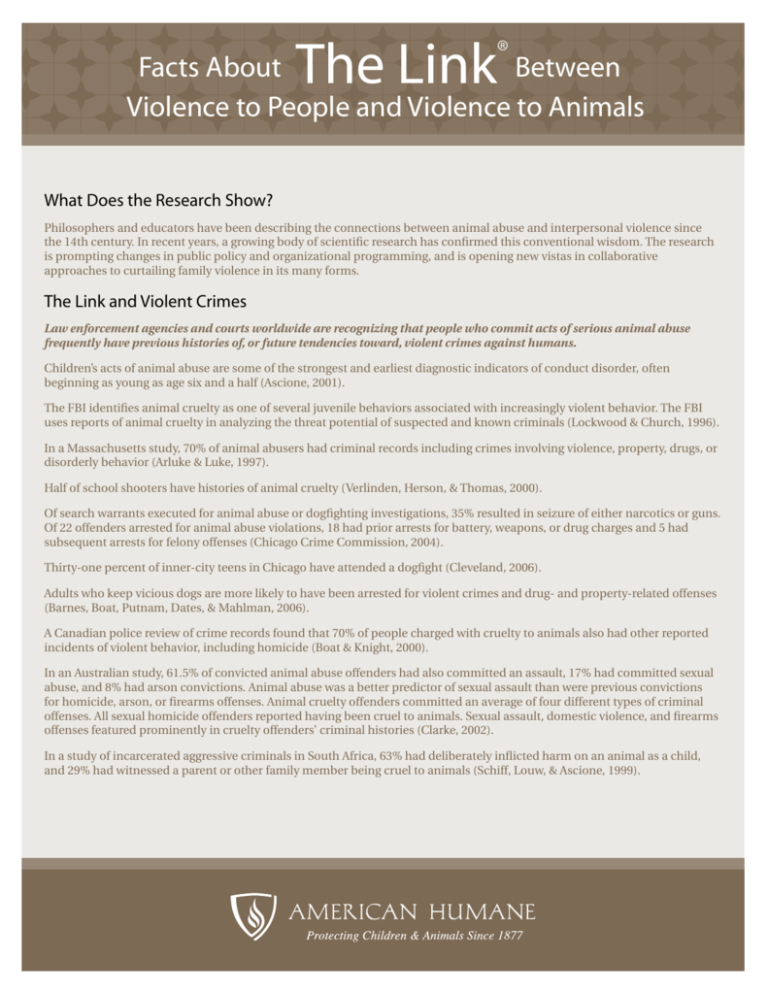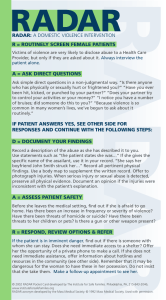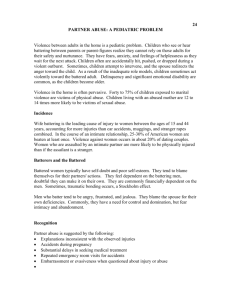
The Link
®
Facts About
Between
Violence to People and Violence to Animals
What Does the Research Show?
Philosophers and educators have been describing the connections between animal abuse and interpersonal violence since
the 14th century. In recent years, a growing body of scientific research has confirmed this conventional wisdom. The research
is prompting changes in public policy and organizational programming, and is opening new vistas in collaborative
approaches to curtailing family violence in its many forms.
The Link and Violent Crimes
Law enforcement agencies and courts worldwide are recognizing that people who commit acts of serious animal abuse
frequently have previous histories of, or future tendencies toward, violent crimes against humans.
Children’s acts of animal abuse are some of the strongest and earliest diagnostic indicators of conduct disorder, often
beginning as young as age six and a half (Ascione, 2001).
The FBI identifies animal cruelty as one of several juvenile behaviors associated with increasingly violent behavior. The FBI
uses reports of animal cruelty in analyzing the threat potential of suspected and known criminals (Lockwood & Church, 1996).
In a Massachusetts study, 70% of animal abusers had criminal records including crimes involving violence, property, drugs, or
disorderly behavior (Arluke & Luke, 1997).
Half of school shooters have histories of animal cruelty (Verlinden, Herson, & Thomas, 2000).
Of search warrants executed for animal abuse or dogfighting investigations, 35% resulted in seizure of either narcotics or guns.
Of 22 offenders arrested for animal abuse violations, 18 had prior arrests for battery, weapons, or drug charges and 5 had
subsequent arrests for felony offenses (Chicago Crime Commission, 2004).
Thirty-one percent of inner-city teens in Chicago have attended a dogfight (Cleveland, 2006).
Adults who keep vicious dogs are more likely to have been arrested for violent crimes and drug- and property-related offenses
(Barnes, Boat, Putnam, Dates, & Mahlman, 2006).
A Canadian police review of crime records found that 70% of people charged with cruelty to animals also had other reported
incidents of violent behavior, including homicide (Boat & Knight, 2000).
In an Australian study, 61.5% of convicted animal abuse offenders had also committed an assault, 17% had committed sexual
abuse, and 8% had arson convictions. Animal abuse was a better predictor of sexual assault than were previous convictions
for homicide, arson, or firearms offenses. Animal cruelty offenders committed an average of four different types of criminal
offenses. All sexual homicide offenders reported having been cruel to animals. Sexual assault, domestic violence, and firearms
offenses featured prominently in cruelty offenders’ criminal histories (Clarke, 2002).
In a study of incarcerated aggressive criminals in South Africa, 63% had deliberately inflicted harm on an animal as a child,
and 29% had witnessed a parent or other family member being cruel to animals (Schiff, Louw, & Ascione, 1999).
The Link
®
Facts About
Between
Violence to People and Violence to Animals
The Link and Domestic Violence
Because women are often emotionally close to, and have primary responsibility for, household animals, they are particularly
vulnerable to batterers who would exploit this bond to exert power and coercion. Millions of battered women are trapped in
abusive homes because there is no one to care for animals that cannot accompany them to safety. Children in these
households are at risk of witnessing and perpetrating this violence as well.
More than 48% of Americans consider their animals as “companions” and almost 50% consider them as “members of the
family” (American Veterinary Medical Association, 2007).
Thirteen percent of intentional animal abuse cases involved domestic violence (Humane Society of the United States, 2001).
Twelve independent studies have reported that between 18% and 48% of battered
women delay leaving abusive situations out of fear for the safety of their
animals (Ascione, 2007).
Over 71% of battered women reported that their batterers had harmed,
killed or threatened animals. More than 75% of these incidents occurred in
the presence of the women and/or children to coerce, control and
humiliate them. More than 13% of the children admitted that they had hurt
pets, and 7.9% admitted to having hurt or killed animals. However, 50% of
the children said that they had protected their pet by directly intervening
(Ascione, Weber, & Wood, 1997).
Thirty-two percent of battered women reported that their children had hurt
or killed animals (Ascione, 1998).
In a Wisconsin study, 68% of battered women reported their animals had
been the target of violence. Of these incidents, 87% occurred in the presence
of the women to intimidate and control them, and 75% occurred in the
presence of children (Quinlisk, 1999).
In a Texas study, batterers who harm animals were found to be more
dangerous and to use more forms of violence and controlling behaviors than
batterers who do not abuse pets (Simmons & Lehmann, 2007).
Children exposed to domestic violence were found to be three times more
likely to be cruel to animals than children in nonviolent households (Currie,
2006).
Forty-eight percent of battered women reported that animal abuse had
occurred “often” during the past 12 months. An additional 30% reported that
the abuse occurred “almost always” (Carlisle-Frank & Flanagan, 2006).
The Link and Child Maltreatment
Children who harm animals or witness acts of violence against animals are at increased risk of developing antisocial
behaviors and of becoming victims of child maltreatment. Conversely, children who are victims of maltreatment are at
increased risk of harming animals.
Pets are part of childhood. Almost 68% of households with children under age 6 and more than 74% of households with
children over age 6 have pets (American Veterinary Medical Association, 2007). A child in America is more likely to grow up
with a pet than with a father (Melson, 2001).
Seven percent of intentional animal abuse cases involved child abuse and neglect (Humane Society of the United States, 2001).
In a New Jersey study, at least one person in 60% of pet-owning families being investigated for child abuse and neglect had
abused animals. At least one person in 88% of pet-owning families being investigated for physical child abuse had abused
animals. In one third of the families, the children had abused the animals, using them as scapegoats for their anger. The rate of
dog bites and attacks in these homes was 69%, compared with 6% in a control group (DeViney, Dickert, & Lockwood, 1983).
Sexually abused children were five times more likely to abuse animals than were children who were not sexually abused
(Ascione, Friedrich, Heath, & Hayashi, 2003).
Twenty percent of children who sexually abused other children also had histories of sexually abusing animals. In most cases,
the acts were carefully planned, with pets targeted, isolated, groomed, and abused ­— much like child victims of sexual abuse
(Duffield, Hassiotis, & Vizard, 1998).
In one survey, 91% of abused children institutionalized for delinquency and
emotional disturbances said they had had special pets, and 99% showed very
positive feelings toward these pets. However, these youths reported that abusive
adults had frequently punished or intimidated them by killing, harming, or
removing their pets (Robin, ten Bensel, Quigley, & Anderson, 1984).
In a British study of animal cruelty cases, 82% of the families investigated
by the RSPCA were also known to social services departments and 61% were
known to probation departments. These families were largely described as
having children at risk (Hutton, 1983).
The Link and Elder Abuse
Senior citizens are at particular risk of hoarding excess numbers of animals
in unhealthy environments. Signs of animal neglect are an early warning
sign of a senior’s self-neglect or need of assistance. Seniors’ emotional
attachments to their pets make them vulnerable to those who would exploit
this bond to exert control over an older victim.
Ninety-two percent of adult protective services caseworkers encountered
animal neglect among clients who were unable to care for themselves.
Seventy-five percent noted their clients’ concern for their pets’ welfare
affected decisions about accepting interventions or other services. Forty-five
percent of adult protective services caseworkers have encountered
intentional animal abuse or neglect (Humane Society of the United States &
State of Wisconsin Department of Health and Family Services, 2003).
A significant percentage of people who hoard or collect animals are older
women (Pet-Abuse.Com, 2007). Their inability to adequately care for large
numbers of animals puts them at risk of self-neglect, eviction, and health
issues, and often indicates a need for mental health and social services
interventions (Patronek, Loar, & Nathanson, 2006).
In the absence of children or other loved ones, animal companions may be particularly significant others for isolated seniors:
the loss of these animals when a senior is forced to move to subsidized housing or assisted living facilities can be traumatic.
Abusive children may attempt to intimidate elders, retaliate against them, or control their assets by harming, threatening,
or removing their pets (Arkow, 2007).
Thirty-five percent of adult protective services caseworkers reported that their clients talk about pets being threatened,
injured, killed, or denied care (Boat & Knight, 2000).
The Link
®
Facts About
Between
Violence to People and Violence to Animals
References
American Veterinary Medical Association. (2007). U.S. pet ownership & demographics sourcebook. Schaumburg, IL: Author.
Arkow, P. (2007, November). Multidisciplinary prevention and intervention: The link between animal protection and adult protection
services. Paper presented at the Texas Department of Family and Protective Services Annual Conference, San Antonio.
Arluke, A., & Luke, C. (1997). Physical cruelty toward animals in Massachusetts, 1975-1996. Society and Animals 5(3), 195-204.
Ascione, F. R. (1998). Battered women’s reports of their partners’ and their children’s cruelty to animals. Journal of Emotional Abuse, 1,
119-133.
Ascione, F. R. (2001, September). Animal abuse and youth violence. Juvenile Justice Bulletin. Washington: U.S. Department of Justice,
Office of Juvenile Justice and Delinquency Prevention.
Ascione, F. R. (2007). Emerging research on animal abuse as a risk factor for intimate partner violence. In K. Kendall-Tackett &
S. Giacomoni (Eds.), Intimate partner violence (pp. 3-1 to 3-17). Kingston, NJ: Civic Research Institute.
Ascione, F. R., Friedrich, W. N., Heath, J., & Hayashi, K. (2003). Cruelty to animals in normative, sexually abused, and outpatient
psychiatric samples of 6- to 12-year-old children: Relations to maltreatment and exposure to domestic violence. Anthrozoös, 16(3), 194-212.
Ascione, F. R., Weber, C. V., & Wood, D. S. (1997). The abuse of animals and domestic violence: A national survey of shelters for women
who are battered. Society and Animals, 5(3), 205-218.
Barnes, J. E., Boat, B. W., Putnam, F. W., Dates, H. F., & Mahlman, A. R. (2006). Ownership of high-risk (“vicious”) dogs as a marker for
deviant behaviors. Journal of Interpersonal Violence, 21(12), 1616-1634.
Boat, B. W., & Knight, J. C. (2000). Experiences and needs of adult protective services case managers when assisting clients who have
companion animals. Journal of Elder Abuse & Neglect, 12(3/4), 145-155.
Carlisle-Frank, P., & Flanagan, T. (2006). Silent victims: Recognizing and stopping abuse of the family pet. Lanham, MD: University Press of
America.
Chicago Crime Commission. (2004, August). RAV2: Reduce animal violence, reduce all violence: A program to amplify human and
animal violence prevention and reduction by targeting dog fighting and animal cruelty. Action Alert, 1-5.
Clarke, J. P. (2002). New South Wales police animal cruelty research project. Sydney, Australia: New South Wales Police Service.
Cleveland, S. (2006, September). Dog fighting and youth: Effects, consequences, and tools for intervention. Paper presented at the annual
conference of the American Humane Association, Schaumburg, IL.
Currie, C. L. (2006). Animal cruelty by children exposed to domestic violence. Child Abuse & Neglect, 30(4), 425-435.
DeViney, E., Dickert, J., & Lockwood, R. (1983). The care of pets within child abusing families. International Journal for the Study of
Animal Problems, 4, 321-329.
Duffield, G., Hassiotis, A., & Vizard, E. (1998). Zoophilia in young sexual abusers. Journal of Forensic Psychiatry, 9, 294-304.
Humane Society of the United States. (2001). 2000 report of animal cruelty cases. Washington, DC: Author.
Humane Society of the United States & State of Wisconsin Department of Health and Family Services Division of Disability and Elder
Services, Bureau of Aging and Long Term Care Resources. (2003). Creating safer communities for older adults and companion animals.
Washington, DC: HSUS.
Hutton, J. S. (1983). Animal abuse as a diagnostic approach in social work: A pilot study. In A. H. Katcher & A. Beck (Eds.), New
perspectives on our lives with companion animals (pp. 444-447). Philadelphia: University of Pennsylvania Press.
Lockwood, R., & Church, A. (1996, Fall). Deadly serious: An FBI perspective on animal cruelty. Humane Society News, 27-30.
Melson, G. F. (2001). Why the wild things are: Animals in the lives of children. Cambridge, MA: Harvard University Press.
Patronek, G. J., Loar, L., & Nathanson, J. N. (Eds.). (2006). Animal hoarding: Structuring interdisciplinary responses to help people, animals
and communities at risk. North Grafton, MA: Hoarding of Animals Research Consortium.
Pet-Abuse.Com. (2007). Animal abuse crime database. Retrieved January 7, 2008, from http://www.pet-abuse.com/pages/cruelty_
database.php
Quinlisk, A. (1999). Animal abuse and family violence. In F. R. Ascione & P. Arkow (Eds.), Child abuse, domestic violence, and animal
abuse: Linking the circles of compassion for prevention and intervention (pp. 168-175). West Lafayette, IN: Purdue University Press.
Robin, M., ten Bensel, R. W., Quigley, J. S., & Anderson R. K. (1984). Abused children and their pets. In R. K. Anderson, B. L. Hart, & L. A.
Hart, (Eds.), The pet connection: Its influence on our health and quality of life (pp. 111-118). Minneapolis: CENSHARE, University of
Minnesota.
Schiff, K., Louw, D., & Ascione, F. R. (1999). Animal relations in childhood and later violent behaviour against humans. Acta
Criminologica, 12, 77-86.
Simmons, C. A., & Lehmann, P. (2007). Exploring the link between pet abuse and controlling behaviors in violent relationships. Journal of
Interpersonal Violence, 22(9), 1211-1222.
Verlinden, S., Herson, M., & Thomas, J. (2000). Risk factors in school shootings. Clinical Psychology Review, 20(1), 3-56.









